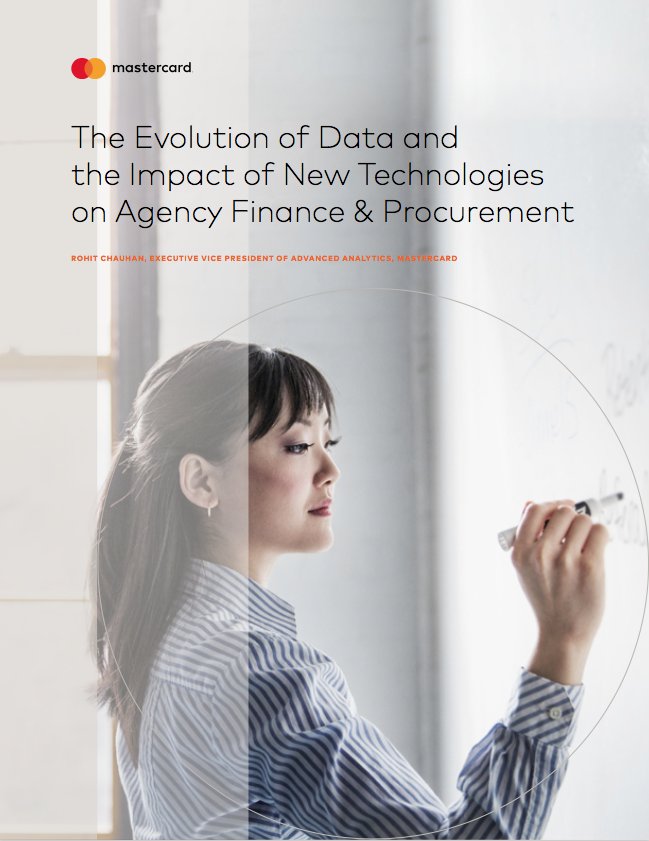The Evolution of Data and the Impact of New Technologies on Agency Finance & Procurement
These technology trends have resulted in better customer experiences, greater efficiencies, and a proliferation of new business models that federal agencies can leverage to improve and modernize.
Presented by
Mastercard

New technologies are converging to positively impact financial management and procurement departments within federal agencies. Mobile, social media, the Internet of Things, cloud computing and big data offer agencies new solutions and provide enormous potential for federal managers seeking to improve efficiencies and eliminate fraud, waste and abuse.
Federal leaders realize that information is a strategic asset, and these five technologies, combined, lay the foundation for the development of high-value solutions that will help agencies deal with the complexity of increased digital information. As a result, federal leaders need search, discovery and analytical tools that will help their agencies gain insights from all data – both structured and unstructured, culled from disparate databases and systems – to better serve the public and meet the requirements of their agencies’ missions.
Analytics will enable government financial leaders, procurement officers and program managers to make smarter and more accurate decisions on spending, better manage suppliers and design more effective strategies.
Here’s why MasterCard thinks these technological trends are important:
- Social Media: The largest social media platform has more than 2 billion monthly active users, larger than the population of India, a sign of the growing influence of social networks. Social media is transforming financial management and services in significant ways, from improving customer service to allowing users to send money to others via online platforms.
- The Internet of Things (IoT): By 2020 there will be 20.4 billion IoT devices connected to the Internet, according to analyst firm Gartner. IoT is the inter-networking of physical devices, such as vehicles, buildings, appliances and other items embedded with electronics, software, sensors and network connectivity. This inter-networking capability between devices enables these objects to collect and exchange data, as well as work together as connected or smart devices. As a result, IoT can help organizations improve efficiency, accuracy and produce the economic benefits of reduced human intervention.
- Cloud Computing: In recent years, federal agencies have turned to cloud computing architectures and solutions to provide services to employees and constituents, as well as to reduce the need for large-scale, traditional IT infrastructure investments. Many agency leaders realize the benefits of supporting mission-critical applications and IT systems with cloud infrastructures that incorporate mobile, social and analytics technologies. Moreover, they recognize the need to implement stringent compliance and security measures that protect their infrastructures from inside and outside threats.
- Big Data: Data is growing exponentially and will continue to grow with the advent of IoT. Federal agencies are seeking tools to better manage and maximize the massive amounts of data being collected from policies and regulations. Analytics can turn this raw data into valuable information that can drive better decision-making around policies and programs, while improving operational efficiency and mitigating agency risk.
- Mobile: Smart phones and tablets are changing the way people in financial services communicate and collaborate with co-workers, access information and interact with customers. The mass adoption of mobile technology has created an environment where workers are expected to leverage mobile technology at work. International Data Corp. forecasts the U.S. mobile worker population will surpass 105 million by 2020, accounting for nearly three quarters (72 percent) of the total U.S. workforce.
These five technology trends, combined, have resulted in better customer experiences, greater efficiencies and a proliferation of new business models that federal agencies can leverage to improve and modernize.
For example:
- Improved Customer Experience (CX): In 2012, the Department of Education’s office of Federal Student Aid launched StudentAid.gov, one of the first agency websites to have a fully mobile-responsive design platform. This innovation allows consumers to access Federal Student Aid information anywhere, anytime and from any device. Social media is expected to have a major role in shaping CX, especially as a forum for resolving customer complaints.
- Operational Efficiency: Officials in cities such as San Francisco and Boston are identifying every pothole that exists in their city by using a software application that consumers download on their cell phones. If a car hits a pothole, the application emits a signal that is picked up by a cloud-based network. Multiple signals from the same location are used to indicate the existence of a pothole. The result of these merged technologies is a more efficient way to identify where the potholes are, and how funds should be allocated to x the problem.
- New Business Models: Some innovative companies have used all five of the technology trends to create new business models. Some companies have developed a market where independent contractors operate a car transportation and food delivery service utilizing a mobile application. For riders, the car service is a convenient, inexpensive and safe taxi service that can be ordered, on-demand, from their smartphones. Federal leaders can also leverage and adopt new innovative business models to better serve their workforce and constituents.
HARVESTING DATA FOR ANALYSIS
The federal government, like commercial companies, can garner greater efficiencies and improve user experiences by leveraging cloud computing, data analytics, IoT, mobile and social media technologies. With new technologies, agencies can harness the value of predictive analytics. As analytics become less expensive, more expansive and faster, federal leaders become more proactive in every area of their operations, and with better precision.
The operational improvements and increased precision allows agencies to better harvest information and ultimately create greater agency value. The proliferation of connected devices increases the volume of data being collected. Agencies can leverage the additional data and apply a spectrum of data analytics to make financial and procurement ecosystems more efficient.
Each age of the data analytics spectrum adds more value:
- Descriptive: First there is descriptive analytics, which focuses on the interpretation of historical data to better understand changes that have happened in the past. Analysts take the data and describe what happened, essentially getting a rearview mirror view of a situation. Descriptive data is interesting information, helping managers to avoid making past mistakes. However, it doesn’t necessarily predict the future.
- Predictive: Next there is predictive analytics, which uses techniques like data mining, statistics, modeling, artificial intelligence and machine learning, to make predictions about unknown future events. This helps federal leaders look forward and determine how to better solve problems.
- Prescriptive: Prescriptive analytics adds the most value because not only does it predict what federal leaders should be expecting from the data, but prescriptive analytics empowers leaders with the information they need to reach their final objectives, and in the most efficient way possible. For example, a Global Position System (GPS) is a prescriptive analytics tool that tells car drivers where to turn to arrive at their destination in the shortest amount of time.
Prescriptive analytics has given rise to new possibilities. With infinite data combined, and thousands of predictions made and optimized overtime, predictive analytics has given rise to capabilities previously unimagined such as self-driving cars.
Sophisticated, analytical tools and techniques using artificial intelligence (AI) can make sense of massive amounts of data, detecting patterns along with the causes and effects of various data points. AI is the simulation of human intelligence by machines, particularly computer systems. It’s a maturing technology that could help companies and government agencies leverage data in more efficient ways.
THE VALUE-OF ARTIFICIAL INTELLIGENCE IN AGENCIES
For government, AI can be applied to a range of functions and disciplines in the financial management space, including but not limited to expense management. Expense management is a collection of systems deployed by a business or agency to process, pay and audit employee-initiated expenses. AI can help agencies address fraud, logistics and procurement within their expense management system and in a predictive manner.
With the right analytical solutions, financial leaders and personnel can find incorrect invoices or payments that may have been made erroneously. These same leaders can also leverage root-cause analysis to determine what caused those errors and correct flaws in the system.
Procurement and program managers can move beyond predictive analysis to prescriptive analysis — the area of business analytics dedicated to finding the be course of action for a given situation. Procurement planning typically involves looking at the prior consumption of certain products and items. The aim is to determine how certain items have been dispensed historically to predict future demand, and determine an organization’s procurement needs for the coming months or years. With prescriptive analysis, procurement leaders should also look at what is being dispensed to make sure their agency keeps up with the internal demand for resources and products.
Too often, procurement leaders are limited by the number of factors they can use to determine product demand. AI will let procurement leaders link product demand to a wider ecosystem to better under and what are the other non-intuitive things that could potentially be driving the demand for a product. This allows analysts to make predictions that drive product demand rather than just relying on the five data points showing what was consumed in the last five months. Procurement leaders can also better determine what is likely to happen in the future. New AI techniques look at lower-level trends that drive the demand along with an understanding of the final numbers.
AI basically commoditizes the process of making predictions, one of the more expensive and labor-intensive areas of analytics. Next-generation AI technology automates the modeling process, enabling anyone, anywhere to easily turn data into actionable decisions. Advanced AI can identify important data features and characteristics and apply continuous adaptive learning capabilities to identify change and evolve behavior.
AI’s potential is vast. For example, the technology has the potential to make self-driving cars much safer than a car driven by a human. That reasoning is based on the learning capabilities and data that the self-driving car will have access to in making decisions. The self-driving car’s decision-making capabilities will be much more robust than humans for multiple reasons. Additionally, there will be no fatigue involved or human error, bad judgment or miscalculations.
Translated into financial planning, AI-driven processes will look at many different dimensions of the ecosystem that humans could never imagine or access, and then construct a model so much more robust than what any individual could create and maintain in a timely fashion.
HOW MASTERCARD IS APPLYING AI
Mastercard is applying evidential reasoning, a form of AI, and machine learning technologies that assist payment processors in identifying employee and consumer purchasing patterns. Machine learning or self-teaching systems, analyze historical transaction data, learning from them to build models that can detect fraudulent patterns as they happen in real time.
Insights on Demand, exclusively for Mastercard helps government agencies detect payment fraud, waste and abuse. The service is offered to federal agencies, in partnership with issuing banks, through the General Services Administration’s (GSA) SmartPay initiative, which helps the government access better payment solutions via partnerships with financial institutions.
Click here to download a PDF version of this article.
This content is made possible by our sponsor. The editorial staff of Government Executive was not involved in its preparation.




